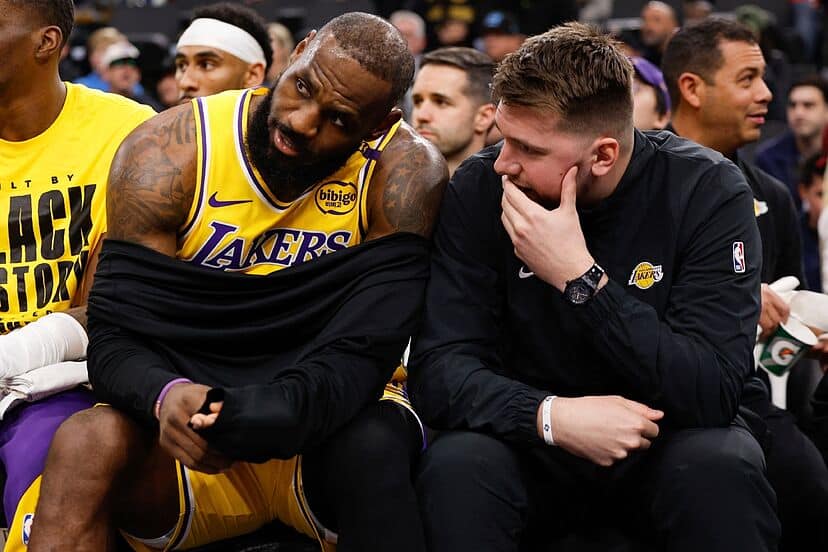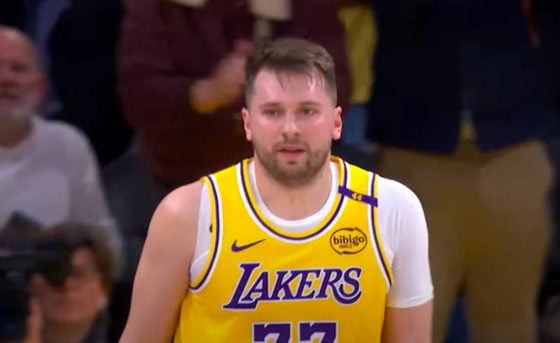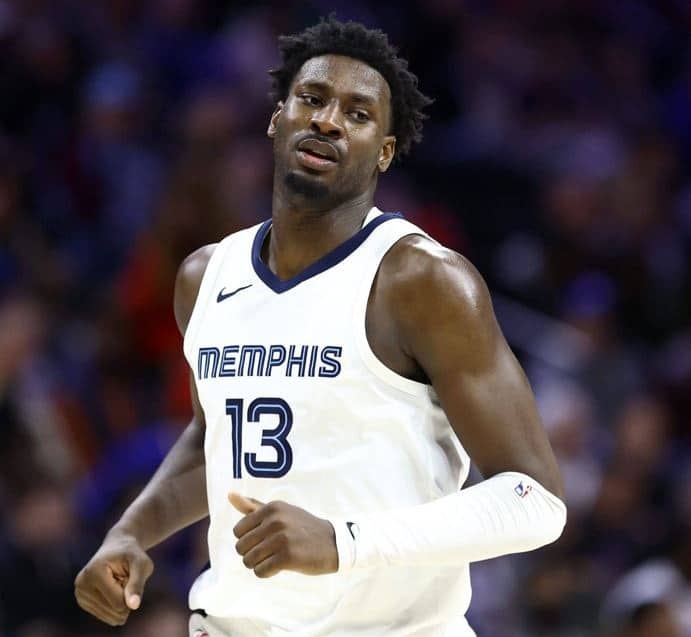There are games like this one where the strategy is so obvious, you start to feel bad for the targeted player. That’s how I felt after the first quarter of this game against the Sixers. As soon as the ball was in the Celtics’ hands, the goal was to attack Joël Embiid’s lack of mobility.
With various setups, the Celtics went at the 2023 MVP relentlessly and generated good shots out of it. At first, Joël Embiid was at the screen level, so the Celtics used that against him and drove deep into the paint.
To avoid opening the driving lane, the 76ers adjusted their approach, keeping Joël Embiid in a drop where he remained low in the paint to protect the rim. This, in turn, led to pull-up triples.
Because the Celtics are so good at attacking drop coverage, the 76ers had to find another alternative. They tried a 2-3 zone with Paul George at the top to contain the drive and use his length. However, this alignment was problematic because the backline consisted of Yabusele, Embiid, and Maxey—three defensive targets who either lack mobility, length, or both.
Later in the game, Nick Nurse had Joël Embiid switch on screens, but this only gave Jayson Tatum the opportunity to make him dance—reminiscent of Game 6 in 2023, where Tatum took over to extend the series to a Game 7.
Safe to say, Joël Embiid doesn’t have the same defensive impact he used to have. Worse, it sometimes feels like the defense is better when he’s off the floor. However, his backups are just as problematic defensively.
#2 – Defensive assignments
On the other end of the court, the Celtics were prepared to match up with the Sixers. The goal was to make entry passes to Joël Embiid as difficult as possible, putting a body between him and the ball. Anyone on the team could take on this role as long as it disrupted the offensive flow.
Once Embiid had the ball, the Celtics preferred to have Jrue Holiday or Kristaps Porzingis defending him. Mixing up defensive matchups against Embiid was crucial due to the number of fouls he generates. By rotating defenders, the Celtics avoided early foul trouble.
Off-ball, the Celtics planned to double Joël Embiid, but not with the player one pass away.
:no_upscale()/cdn.vox-cdn.com/uploads/chorus_asset/file/25881710/Boston___Phily___Post_up_rotation.png)
The goal was to force Embiid to give up the ball while making it difficult for him to find an open teammate. The more complicated the pass, the more time the Celtics had to rotate off-ball and contain the other four players. However, it didn’t work well at first.
#3 – Early defensive breakdowns
Early on, the Celtics lacked discipline and couldn’t stop the Sixers’ offense around Joël Embiid. They allowed entry passes too easily, and their help defense was too easy to beat.
With Embiid’s post-up gravity drawing attention, the Sixers were able to cut into space and punish the Celtics’ lack of defensive discipline, generating easy shots at the rim or open threes. Despite suboptimal spacing, they found ways to exploit the defense.
To shrink the floor and add size, the Celtics quickly turned to their double-big lineup—where Luke Kornet was key in slowing down the 76ers’ offense.
#4 – Kornet’s rim protection
Despite playing on Kristaps Porzingis’ team and going up against Joël Embiid, Luke Kornet might have been the best rim protector last night. One play in particular highlighted his defensive performance in the first half.
Matched up against Kelly Oubre, who attacked from a pick-and-pop action, Kornet—a seven-footer—went under the screen, used his length, and positioned himself perfectly to meet Oubre at the rim. He disrupted the layup, turning the play into a transition opportunity. Impressive!
Whenever he was on the floor, the defense felt more solid. Whether playing off-ball as a safety or on-ball containing drives and post-ups, Kornet was a key factor in slowing down the Sixers’ offense.
His ability to protect the rim gives the Celtics a unique advantage, ensuring they have a strong interior defender on the floor for all 48 minutes. When Porzingis sits, Kornet continues to provide tremendous defensive value.
#5 – New variation from sideline actions
If you’ve read some of my previous 10 takeaways, you know I enjoy analyzing the Celtics’ new twists on their classic sideline actions this season. If not, here’s a quick recap: the Celtics like to run stagger actions from the baseline or sideline—essentially, two screens set for an off-ball player.
First, they ran it for Jaylen Brown. Instead of going above both screens, he first went under, then above, dragging Embiid as high as possible. Following the off-ball screen, Porzingis popped to the three-point line while Brown dove to an open rim.
The next play was a classic—two screens generating an open three for Payton Pritchard. He ran above the Hauser and Kornet screens, leaving Grimes too far behind when he received the ball.
In the last example, they took it a step further. Pritchard baited Grimes into the screen but then cut to the rim, allowing Sam Hauser to use the Kornet screen instead. This created confusion and forced a switch. Kornet rolled inside, dragging Oubre with him, leaving Pritchard wide open again.
Chess, not checkers.
#6 – JT & Kornet synergy
Speaking of offensive movement, the synergy between Luke Kornet and Jayson Tatum is a joy to watch. We’ve become accustomed to their pick-and-roll action, but they added a new wrinkle last night with a two-man game that tricked Paul George.
Kornet’s passing, rim-finishing ability, and strong screens complement Jayson Tatum’s scoring, ball-handling, and off-ball movement perfectly.
#7 – Dealing with Maxey’s dilemma
Maxey once again proved difficult for the Celtics to contain. His speed allowed him to get to the rim too easily, and the Celtics were often caught off guard by how quickly he moved. The young guard has also improved his passing, making him even harder to slow down.
Yet, the Celtics’ offense looked its best when he was on the floor. Like Darius Garland or Damian Lillard, Maxey is a defensive target for every player on the court. Whether it was Derrick White, Jrue Holiday, or even Al Horford, they all attacked him and took advantage of his defensive weaknesses.
This raises the question: how much value does Maxey bring against the Celtics if he is constantly being targeted—despite his ability to collapse defenses on the other end?
#8 – Fireworks
A staggering 58% of the Celtics’ shot attempts were threes, and they converted 44% of them—unstoppable. Seven different players hit multiple triples. Some nights, the Celtics just look unbeatable.
#9 – Out-hustled
The Celtics sometimes get beaten by teams that outwork them. Last night, they dominated the Sixers with their energy—and this play was a great example. Al Horford saved the ball for the first offensive rebound, then scored off a second one.
The Sixers looked broken. Despite having a strong roster on paper, they simply couldn’t match the Celtics’ energy and talent.
#10 – Pritch please
For the 18th time this season, Payton Pritchard made more than five three-pointers in a game. The future Sixth Man of the Year brought incredible energy and spacing. Alongside Kornet, he was the difference-maker last night.
The Celtics initially struggled to build a big lead, but Pritchard’s shooting and ability to generate chaos quickly killed the 76ers’ hopes. His knack for creating defensive mayhem makes him invaluable. He brings a spark that the starting five sometimes lacks, generating more movement than any other Celtics player—a huge asset.
:no_upscale()/cdn.vox-cdn.com/uploads/chorus_asset/file/25881712/Capture_d_e_cran_2025_02_21_a__09.13.53.png)






